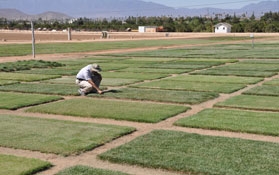Posts Tagged: lawn
'Mow, blow and go' workers another drought casualty
If you take out 5.4 million square feet of turf across Orange County, you save 645 million gallons of water. But you also uproot an entire industry, reported Aaron Orlowski in the Orange County Register.
The reporter spoke to a yard worker who said customers are asking for service once a week, where they used to have it twice a week.
“The grass is starting to die out because they've been told to bring down their watering times. Before, they watered two times a day, four times a week. Now, they only water once a week," the worker said.
But in time, the industry is bound to adjust to a new water-conserving reality, assured Doug Parker, director of the University of California Agriculture and Natural Resources (UC ANR) California Institute for Water Resources.
“Eventually, with redesign and installation, those landscapes will need maintenance as well. So it could be in the long term, those maintenance crews come back to where they were," Parker said. "They may not be mowing as much as they were, but the bushes will still need to be trimmed.”
Other drought news:
Ag woes have big impact on San Joaquin Valley economy
Tim Hearden, Capital Press, May 21, 2015
While agriculture may seem small compared to the entire California economy, it has a big impact on commerce in the San Joaquin Valley, according to Daniel Sumner, director of UC ANR's Agricultural Issues Center. “Statewide, agriculture is 2 percent of the state's economy,” Sumner said. “That's the number, and if agriculture is cut 10 percent, that's two-tenths of 1 percent (of the economy).” But, he adds, “…That doesn't mean it's tiny.” In some communities in western Fresno County, a lack of ag-related jobs because of fallowed acres has led to an unemployment rate of nearly 40 percent.
Green going out of fashion in California
Many Californians are beginning to reluctantly accept that a well-manicured, lush green lawn is no longer a realistic landscape feature in the arid West, reported Steven Kurutz in the New York Times.
Chuck Ingels, UC Cooperative Extension advisor in Sacramento County, told the reporter homeowners with traditional green lawns may soon have no choice but to let them go brown. An average of 50 to 60 percent of a household's water consumption goes to outdoor use, which includes the landscape. He envisions a future in which lawns go dormant in winter and in summer, if watering is not allowed.
“The water bills are going up,” Ingels said. “I think we're going to start seeing more and more people opt for a brown lawn. I think it could become more traditional.”
If some water is available, there are less thirsty alternatives to traditional lawns that can provide a similar effect. Ingels has experimented with meadow-like buffalograss and dune sedge as alternatives. For example, UC Verde buffalograss, released in 2003, was bred for the California climate by UC researchers. It needs only infrequent mowing, uses half the water of tall fescue and is disease and pest resistant.
Other options are drought-tolerant native species like carex and bentgrass. These can be used for the meadow effect if not mowed, or mowed regularly for a more traditional look.
Water-efficient plants highlighted at turfgrass event
Reporter Laurie Lucas covered UC Riverside's turfgrass field day for The (Riverside) Press-Enterprise. Approximately 200 homeowners, park managers, water experts, scientists, nursery professionals and golf course supervisors attended the event. One of the 13 projects highlighted at the Turfgrass Research Facility's event examined water-efficient groundcover, including rosemary, thyme and iceplant. UC Cooperative Extension specialist Donald Merhaut commented on the plants' response to reduced water. "Most of the 18 species we grew with limited irrigation did well," he told the reporter. "But the geraniums showed the most direct heat stress." The article also highlighted trailing purple lantana, blue rug juniper, honeysuckle, vygie, grey saltbush and morning glory as other alternatives for cool-season grasses.
PopSci pursues the perfect lawn
Popular Science, the world's largest science and technology magazine, spotlighted the work of UC Riverside Cooperative Extension turf scientist Jim Baird in its May 2010 "Statistically Speaking" feature. Titled "The Perfect Lawn," the full-page story said Baird is bioengineering grass that drinks less water and still earns praise for its lush, emerald green appearance.
"The process is sort of a gladiator academy for grass," PopSci says. The scientists grow promising hybrids, then turn off the water to see which ones survive.
The article opens with statistics on turf grass' ability to sequester carbon. U.S. lawns, it says, could trap enough carbon each year to offset the emissions from burning 1.9 billion gallons of gasoline. However, it takes 7 billion gallons of water a year to keep the grass green.
Other statistics in the feature were:
- 625 square feet - Area of lawn needed to make enough oxygen for one person for one day
- 1.57 billion hours - Time homeowners spend mowing the lawn per year
- 37 billion pounds - Carbon dioxide that residential lawns can store per year
- 800 million gallons - Amount of gas guzzled by lawn mowers annually
- 33,000 square miles - Area of the U.S. covered by residential lawns

Jim Baird



